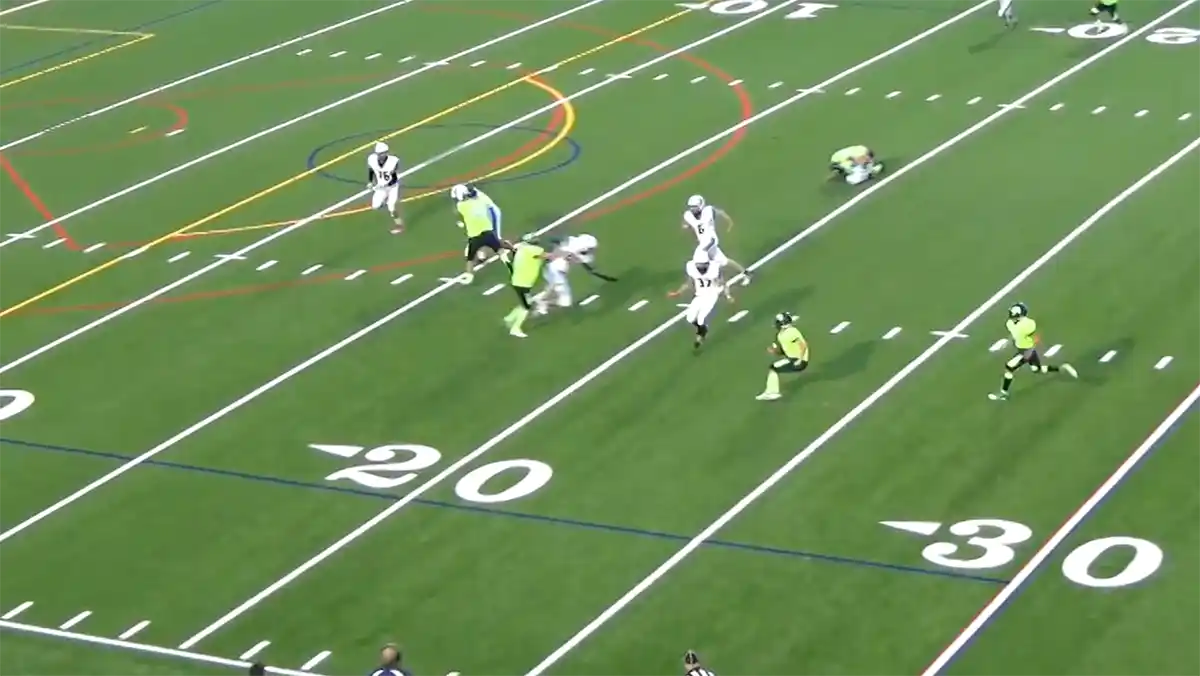It’s interesting how we can sometimes review a play’s description on paper and quickly and confidently decide how we’d officiate the action, but when we see the same play on the football field, it takes us by surprise and we panic/freeze (and sometimes make incorrect decisions).
The punch line is, the kicking game provides most of the “wonky” plays we’ll see on the gridiron, and we must mentally prepare for unusual events during scrimmage kicks.
- The R and BJ must be ready to rule on a momentum exception if the receiver catches the ball inside the R-5.
- The wings must be ready to rule on KCI and first touching when a scrimmage kick is high and short and multiple players are under the ball as it descends.
- The linesman must be prepared for a scrimmage kick to bounce back behind the LOS.
- The entire crew must look for blocks in the back and blindside blocks.
- The entire crew must stay off their whistles and properly officiate a blocked field goal (non-try) attempt.
A scrimmage kick bounces behind the neutral zone
Rule 6-2-3 (scrimmage kicks) states:
“Any K player may catch or recover a scrimmage kick while it is in or behind the neutral zone and advance, unless it is during a try.”
We recognize “on paper” if a Team K player recovers a blocked scrimmage kick or catches a scrimmage kick behind the neutral zone (I’ve seen that on video), or if a Team K player recovers a high kick that bounces back behind the neutral zone; the player can run, kick, or pass the ball.
Unfortunately, in the past half-dozen years our crew has had a scrimmage kick bounce back behind the neutral zone three times, and we’ve had three inadvertent whistles (including one from yours truly). In each case, the ball was kicked high, bounced back behind the neutral zone, and a Team K player recovered. Each time, an official blew his whistle to kill the play. (We had even pre-gamed this uncommon event before my inadvertent whistle and it still took me by surprise!)
In this clip, the ball bounces more than 10 yards beyond the line of scrimmage and then bounces back behind the neutral zone. A kicking team player recovers the kick behind the neutral zone and then (not realizing he can advance the ball) runs out of bounds. He could have run down the sideline for significant yardage.
In this example, the kick never crosses the neutral zone and a kicking team player picks it up almost exactly at the original line of scrimmage. The line judge is standing at that yard line and immediately kills the play. This may have been an inadvertent whistle.
In this play, the kicking team player recovers the kick a half-yard behind the line of scrimmage. The crew does not kill the play and the runner hesitates a half-second and then advances downfield.
All Heck Breaks Loose During Scrimmage Kicks!
Return team fouls
If the return team fouls, it will most likely be for holding or an illegal block in the back. The wings must resist the urge to stare into the backfield at the kicker and instead must focus on their keys (the gunners). The back judge is focusing on the receiver and sometimes can catch BIB fouls, but the wings are primarily responsible for observing that foul.
After the linemen pass the umpire, he can look for fouls in the second wave behind the gunners. The second wave will often illegally block in the back.
In this drone video, the back judge flags two blocks in the back, one at the R-43 near the receiver and a second at midfield. Notice he doesn’t stop officiating or lose focus after the first flag.
In this clip, the return team commits a holding foul (takedown!) at the K-41 and an illegal block in the back foul at the R-45. Both fouls were missed. At the end of the clip, you can see the two players involved in the takedown get up, grapple, and spin out of bounds at the K-40 well into the home team’s bench area. A lot is going on during this scrimmage kick play.
Watch for headhunters!
As with interception returns, during scrimmage kick returns the crew must laser-focus on colors going against the flow. During returns, players no longer have assigned blocking responsibilities, so they often look for the most lucrative target. Off-ball officials must look for blindside blocks, blocks in the back, and blocks below the waist.
Here is a GREAT flag by the back judge. Eight seconds into the clip you can see a return team player (in white) appear on the left side of the video at the K-22. He runs across the field and slams into a return team blocker at the K-28. At the end of the clip, you can see the BJ wind up and throw his flag.
In this clip, the umpire throws a flag for a takedown at the K-20, but the crew misses two blindside blocks, one at the K-17 and a big one at the K-25, 10 yards behind the runner. During returns, headhunters look for a lucrative target to deliver punishment.

